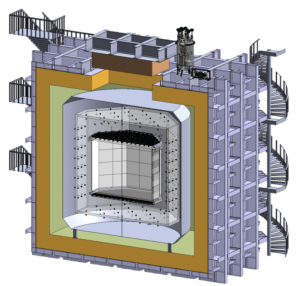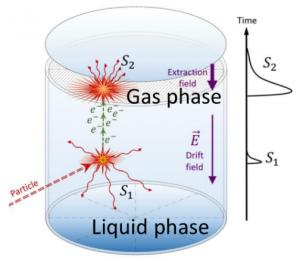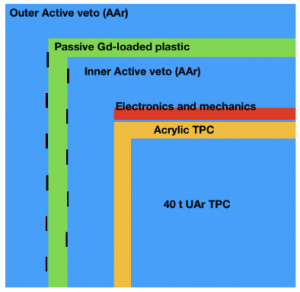
The DarkSide-20k cryostat containing the veto system and the argon TPC.
The next step: DARKSIDE-20k
Most of the DEAP collaboration has joined the Global Argon Dark Matter Collaboration (GADMC). The follow-up to the DEAP-3600 detector will thus be DarkSide-20k: a multi-hundred tonne argon project just starting its development. Its ultimate spin-independent WIMP-nucleon scattering sensitivity near 10-48 cm2 is close to the sensitivity limit set by fundamental backgrounds from atmospheric neutrinos. The detector will require a large low-background acrylic vessel and low-radioactivity argon to avoid high event rates and backgrounds from 39Ar.
The baseline design of the detector is based on a dual-phase time projection chamber (TPC) hosted in a cryostat similar in design to the one developed for ProtoDUNE, a prototype for the massive DUNE neutrino experiment to be installed at FermiLab and Sanford Mine.
The Time Projection Chamber Concept

Working principle of the time projection chamber (TPC) detector
The argon time projection chamber detector concept applied to dark matter searches has been already successfully applied in the DarkSide-50 experiment. Dark matter searches based on xenon used the same concept in different experiments like LUX, XENON, and PandaX. In a TPC, two signals are recorded for each event and are called conventionally S1 and S2 (see figure). In general, in the interaction of dark matter or other particles in the detector, scintillation photons and ionization electrons are produced. S1 corresponds to scintillation photons produced almost instantly at the time of the interaction (of dark matter or other particles) in the noble liquid. S2 is the signal associated to the drift of electrons from ionization. In a TPC, a strong electric field is applied for forcing the ionization electrons produced in the interaction to drift in a certain direction. The TPCs used in dark matter searches are in particular two-phase TPCs: this means that on the surface of the liquid, argon is in the gas phase. When the drift electrons, accelerated by the electric field, reach the gas, they produce photons constituting the S2 signal. Photosensors are placed on the top of the TPC and are able to reconstruct the X/Y coordinates of the event measuring S1. Measuring the time difference between S1 and S2 and knowing the drift velocity of the electrons, it is possible to reconstruct also the Z (vertical) coordinate. Thus a TPC is able to fully reconstruct the location of an event within the argon volume. This ability is crucial for the rejection of backgrounds, which are concentrated close to the TPC walls.
The detector concept
For minimizing the backgrounds from 39Ar, the TPC will be made of acrylic walls and filled with underground argon (UAr). The light produced by particle interactions in UAr will be detected by silicon photomultipliers. The whole TPC will be immersed in atmospheric liquid argon (AAr) which will play the role of veto detector. The AAr is divided in two concentric volumes by a gadolinium-doped acrylic vessel for neutron detection (see figure). The design has the advantage of keeping the cryostat walls far from the TPC.
Underground Argon

Schematic view of the DarkSide-20k detector. The TPC is placed at its center and it is surrounded by the veto system.
Atmospheric argon (AAr) contains traces of 39Ar which contribute through beta decays to the backgrounds. With such a large argon volume as in DarkSide-20k, it is mandatory to reduce this contamination for reaching high sensitivity levels. The idea is to use underground argon (UAr), which was not exposed to cosmic rays which are responsible for the creation of 39Ar. The UAr will be extracted from a facility in the US (Urania project) and shipped for chemical purification to Sardinia, Italy (Aria project). After the distillation, the purified argon will be shipped to Gran Sasso. The UAr will be used only for the TPC, while AAr will be used for the veto detector.
The future:
The final goal of liquid argon technology is to build a 400t scale detector for collecting an exposure of 1000t/yr without instrumental backgrounds. Such a detector will have the potential to reach the “neutrino floor” (the background from solar and atmospheric neutrinos), reaching the ultimate limit for noble liquid-based DM detectors.
